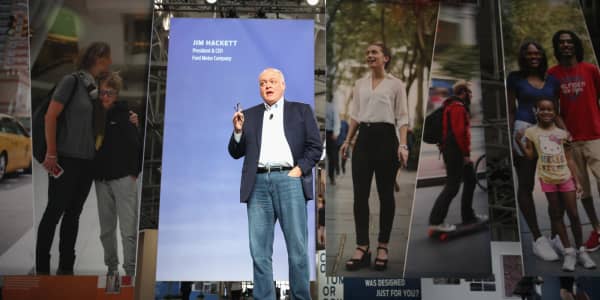Going up against the likes of beauty industry giants L'Oréal and Avon calls for a big strategy. But in the case of Stowaway Cosmetics, smaller is better. Having just marked its one-year anniversary, the e-commerce site's plan to appeal to women on the move with "right-sized" premium makeup products that are easy to tuck and transport appears to be a great fit for consumers.
The decision to come up with a line of smart beauty solutions for women with busy lifestyles came over breakfast one morning in 2014 when co-founders Julie Fredrickson and Chelsa Crowley starting venting about having to constantly tote around large, heavy cosmetics.
"It's not the 1950s," said Fredrickson, the company's CEO. "We're not sitting around our boudoir. Our makeup is going with us. … Lives today are busier, more full and more challenging, and having the tools at your disposal to be polished when you need it is a powerful thing."
With Fredrickson's background in digital marketing — she created e-commerce and brand marketing strategies for the likes of Pepsi, Nike, Michael Kors, Club Monaco and Coach — and Crowley's as a former makeup artist who worked in-house at Clinique and on editorial content for trendy makeup company Bobbi Brown, they believed they had the perfect skill set to create a brand tackling a market that is 70 percent controlled by 10 conglomerates.
According to Statistic Brain Research Institute, L'Oréal tops the list of cosmetic brands worldwide, with a brand value of $10.7 billion, followed by Avon ($7.9 billion), Pantene ($6.1 billion), Nivea ($6 billion) and Dove ($5.8 billion).
By February 2015, Stowaway's founders had raised $1.5 million in funding, selling their premium-products-in-portable-sizes idea to more than a dozen investors, including Kima Ventures, fashion icon Marc Ecko and Internet personality and angel investor Gary Vaynerchuk, whose list of companies include Birchbox, Uber and Grand St.
With their backing, Stowaway joined the new breed of online native brands, such as Warby Parker and Bonobos, to sell its simple line of luxury cosmetics directly to the consumer, cutting out third-party retailers. In September, Stowaway started a subscription service, whereby products are auto-replenished every three, six or nine months.
A year later the women are still optimistic. Although they will not disclose sales figures, they cite 500 percent revenue growth month-over-month from May through December and a 25 percent repurchasing rate for the two quarters. "During the holidays, we sold over 100,000 lipsticks," Fredrickson said.
"We benchmark against products we like," Fredrickson said. "We are comparable to a Nars or a Bobbi Brown. Something you would find at a Saks, Nordstrom or Niemans beauty counter," she said, explaining that the smaller packaging allows for a smaller price point, providing consumers the ability to buy an expensive brand at half the price. "If something is selling there for $45, ours is going to be $22. It's a better value all around, because you're not going to toss it."
Crowley, Stowaway's CCO, agrees: "There's no value in buying something you can't or won't use. That's just pouring money down the drain."
The most expensive item is its BB cream, at $22. They also make bundled items that are fully customizable, such as the Stowaway Kit, their best seller. Called their "little black dress of beauty," it is priced at $75 and contains a mascara, lipstick, concealer, BB cream, cheek rouge and eyeliner. The whole kit can easily fit into a small purse.
'Designed to be finished'
Stowaway claims its right-sized brand addresses two powerful issues: waste and safety. Stowaway's smaller packaging, says Crowley, enables consumers to use up the makeup before it expires, avoiding bacteria buildup, which can cause breakouts and other conditions, such as conjunctivitis.
"Seventy-five percent of cosmetic users don't finish the makeup they own — not just before it expires, but at all," Fredrickson said. Her finding is based on a recent survey Stowaway conducted with consumer insight company Poshly, in which the company polled more than 4,000 women about their purchasing habits and how they use makeup in their daily lives.
The survey also found that more than 80 percent of women have problems with old product, yet they still don't discard them, because they forget, feel guilty about the money they spent on it or worry they may need it later. In fact, the survey said, 89 percent of women hang on to old makeup "just in case they might need it later," even though 87 percent of them know that makeup has expiration dates.
What's more, claims the survey, the average consumer owns almost 40 makeup products but only uses and carries five of them daily. "These products are designed to be finished," Crowley said.
According to the Federal Drug Administration, there are no regulations or requirements under current U.S. law that require cosmetic manufacturers to print expiration dates on the labels of cosmetic products. "Manufacturers have the responsibility to determine shelf life for products, as part of their responsibility to substantiate product safety," says the FDA website.
"We can't say you can't use a product over a certain date, and we don't have the authority to require safety data before cosmetics go on the market," said FDA spokesperson Lauren Sucher. "We can only take action after the fact if consumers have adverse effects," she said.
"I don't know how often people really have a problem with expiration dates. I don't think we need more regulations, but people should be made aware," said Dr. Gwen Abeles, of Abeles Dermatology Aesthetic and Laser Arts in Montvale, New Jersey.
"It's not a common problem, but opening and closing liquid makeup a lot over a long time can subject you to infection," said Dr. Karen Burke, associate clinical professor in the Department of Dermatology at Mount Sinai Medical Center in New York. "So can storing makeup for many months and then taking it out again to use it. Dry cosmetics keep longer."
Abeles recommends replacing mascara every two months and lipstick every six. She also suggests sharpening eyeliners and lip liners after every use. "A good rule of thumb for foundations and creams is to replace them six months to a year," she said. "But if you're sticking your fingers in the creams all the time, that's going to decrease the shelf life."
She adds: "Is it a huge problem? I don't think so. But making makeup in smaller packages is a neat idea."








